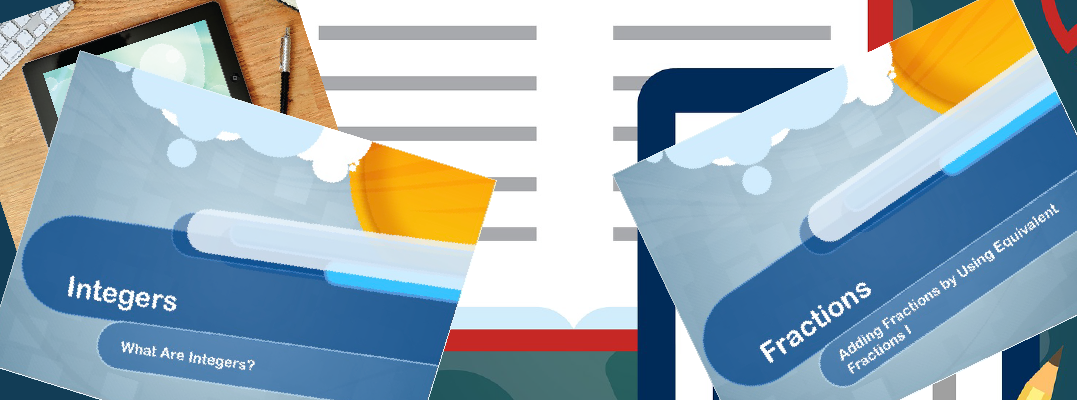Content Showcase: Video Transcripts
Media4Math has video transcripts for many of our videos. When you subscribe to Media4Math, you can download these transcripts.
This is a growing collection of resources, so keep coming back!
(Want to learn more about our subscription packages? Click here.)
| Title | Description | Thumbnail Image | Curriculum Topics |
|---|---|---|---|
Video Transcript: Geometry Applications: Antiprisms |
Video Transcript: Geometry Applications: AntiprismsThis is the transcript for the video: Geometry Applications—Antiprisms. In this video students learn the basics of antiprisms, in the context of New York’s Freedom Tower, which has an antiprism design. They learn the properties of antiprisms, with the focus on those with a square base. |

|
3-Dimensional Figures |
Video Transcript: Geometry Applications: Rectangular Prisms |

|
Rectangular Prisms | |
Video Transcript: Geometry Applications: What Are Prisms? |
Video Transcript: Geometry Applications: What Are Prisms?This is the transcript for the video: Geometry Applications--What Are Prisms? In this video students learn the basics of prisms and anti prisms. They learn the properties of triangular prisms, rectangular prisms, triangular antiprisms, and rectangular antiprisms. |

|
Rectangular Prisms and Triangular Prisms |
Video Transcript: Geometry Applications: Triangular Prisms |
Video Transcript: Geometry Applications: Triangular PrismsThis is the transcript for the video: Geometry Applications--Triangular Prisms. In this video students study a real-world application of triangular prisms: The Flat Iron Building in New York City. This building is an ideal example of a real-world prism and also provides a tie-in to right triangle geometry. |

|
Triangular Prisms |
Video Transcript: Geometry Applications--Volume of a Pyramid |
Video Transcript: Geometry Applications--Volume of a PyramidThis is the transcript for video entitled: "Geometry Applications--Volume of a Pyramid." |

|
Pyramids |
Video Transcript: Geometry Applications: Points and Lines, Segment 3: Lines |
Video Transcript: Geometry Applications: Points and Lines, Segment 3: LinesThis is the transcript for the video of same title. Video contents: Many cities are laid out in a rectangular grid and are examples of intersecting lines and rays. We visit the city of Houston to investigate the geometric nature of the city grid in its downtown area. We explore properties of intersecting and parallel lines and why this is the most efficient way to organize a city or community. |

|
Applications of Points and Lines |
Video Transcript: Geometry Applications: Points and Lines, Segment 2: Points |
Video Transcript: Geometry Applications: Points and Lines, Segment 2: PointsThis is the transcript for the video of same title. Video contents: Geometric objects are abstractions that seem to have a connection to real world objects. In the case of a geometric point, we visit the CERN particle accelerator in Switzerland, where the smallest known subatomic particles are produced, to see how subatomic particles compare to geometric points. A mathematical analysis reveals the nature of geometric points and point-like materials objects. |

|
Applications of Points and Lines |
Video Transcript: Geometry Applications: Polygons |
Video Transcript: Geometry Applications: PolygonsThis is the transcript for the video of same title. Video contents: In this program we explore the properties of polygons. We do this in the context of two real-world applications. In the first, we look at Islamic tile patterns as examples of regular polygons. We explore how such intricate patterns were created using a compass and straight edge. In the second application we look at composite figures, specifically in the context of the design of the Petronas Towers in Indonesia. |

|
Applications of Polygons |
Video Transcript: Geometry Applications: Polygons, Segment 1: Introduction |
Video Transcript: Geometry Applications: Polygons, Segment 1: IntroductionThis is the transcript for the video of same title. Video contents: The Pentagon is one of the most famous polygon-shaped buildings in the world. But why was this shape chosen over a more straightforward quadrilateral shape? We briefly explore the properties of pentagons and use this as a way of introducing the key concepts throughout the program. |

|
Applications of Polygons |
Video Transcript: Geometry Applications: Polygons, Segment 2: Properties of Polygons |
Video Transcript: Geometry Applications: Polygons, Segment 2: Properties of PolygonsThis is the transcript for the video of same title. Video contents: In the ancient city of Marrakesh polygons are on display. As part of the Islamic tile work prevalent throughout the Middle Ages, Marrakesh provides an opportunity to explore the properties of polygons, and how these properties are taken advantage of in the intricate designs found throughout this fascinating city. |

|
Applications of Polygons |
Video Transcript: Geometry Applications: Polygons, Segment 3: Composite Figures |
Video Transcript: Geometry Applications: Polygons, Segment 3: Composite FiguresThis is the transcript for the video of same title. Video contents: The Petronas Towers in Indonesia provide an opportunity to explore the composite shapes used in the design of the towers. |

|
Applications of Polygons |
Video Transcript: Geometry Applications: Quadrilaterals |
Video Transcript: Geometry Applications: QuadrilateralsThis is the transcript for the video of same title. Video contents: In this program we explore the properties of quadrilaterals. We do this in the context of two real-world applications. In the first, we explore the architecture of Frank Lloyd Wright as an application of squares and rectangles; in particular, we look at his Fallingwater house. In the second application we look at a unique parallelogram-shaped building in Spain, known as the Puerta de Europa. |

|
Applications of Quadrilaterals |
Video Transcript: Geometry Applications: Quadrilaterals, Segment 1: Introduction |
Video Transcript: Geometry Applications: Quadrilaterals, Segment 1: IntroductionThis is the transcript for the video of same title. Video contents: Stonehenge is best known as a circular structure. But it's the post and lintel construction used that is noteworthy, and this type of construction involves quadrilateral shapes. From the familiar door frames of houses to the majestic entryways of ancient temples, post and lintel construction provides a clear introduction to the nature of quadrilaterals. |

|
Applications of Quadrilaterals |
Video Transcript: Geometry Applications: Quadrilaterals, Segment 2: Squares and Rectangles |
Video Transcript: Geometry Applications: Quadrilaterals, Segment 2: Squares and RectanglesThis is the transcript for the video of same title. Video contents: Frank Lloyd Wright's architectural masterpiece Falling Water is also a stunning assembly of quadrilateral shapes. Some of the rectangular forms in this building seem to defy gravity, as we explore the properties of squares and rectangles that allowed Frank Lloyd Wright to push the envelope of design and structure. |

|
Applications of Quadrilaterals |
Video Transcript: Geometry Applications: Quadrilaterals, Segment 3: Parallelograms and Trapezoids |
Video Transcript: Geometry Applications: Quadrilaterals, Segment 3: Parallelograms and TrapezoidsThis is the transcript for the video of same title. Video contents: The Puerta de Europa towers in Madrid bring parallelograms front and center. These tilted towers, looking like modern-day towers of Pisa seem to defy gravity, but rely on the stability brought about by its quadrilateral structure. The underlying parallelogram and trapezoidal designs are explored and analyzed. |

|
Applications of Quadrilaterals |
Video Transcript: Geometry Applications: Transformations |
Video Transcript: Geometry Applications: TransformationsThis is the transcript for the video of same title. Video contents: In this program we look at applications of transformations. We do this in the context of three real-world applications. In the first, we look at translations and rotations in the context of roller coaster rides. In the second example we look at translations in three-dimensional space in the context of cargo ships. In the third example, we look at the design of observatories to look at rotations, reflections, and symmetry. |

|
Applications of Transformations |
Video Transcript: Geometry Applications: Transformations, Segment 1: Translations and Rotations |
Video Transcript: Geometry Applications: Transformations, Segment 1: Translations and RotationsThis is the transcript for the video of same title. Video contents: Roller coasters provide an ideal opportunity to explore translations and rotations. Displacement vectors are also introduced. |

|
Applications of Transformations |
Video Transcript: Geometry Applications: Transformations, Segment 2: 3D Translations |
Video Transcript: Geometry Applications: Transformations, Segment 2: 3D TranslationsThis is the transcript for the video of same title. Video contents: Cargo ships transport tons of merchandise from one country to another and accounts for most of the global economy. Loading and unloading these ships requires a great deal of organization and provides an ideal example of three-dimensional translations. |

|
Applications of Transformations |
Video Transcript: Geometry Applications: Transformations, Segment 3: Rotations, Reflections, and Symmetry |
Video Transcript: Geometry Applications: Transformations, Segment 3: Rotations, Reflections, and SymmetryThis is the transcript for the video of same title. Video contents: The Gemini telescope in Hawaii is an example of architecture that moves. All observatories rotate in order to follow objects in the sky. This also provides an opportunity to explore rotations, reflections, and symmetry. |

|
Applications of Transformations |
Video Transcript: Geometry Applications: Triangles |
Video Transcript: Geometry Applications: TrianglesThis is the transcript for the video of same title. Video contents: In this program we explore the properties of triangle. We do this in the context of two real-world applications. In the first, we explore the triangular trusses in the Eiffel Tower and in the process learn about key properties of triangles. In the second application, we look at right-triangle-shaped sails on sail boat and why these are the ideal shape for efficient sailing. |

|
Applications of Triangles |
Video Transcript: Geometry Applications: Triangles, Segment 1: Introduction |
Video Transcript: Geometry Applications: Triangles, Segment 1: IntroductionThis is the transcript for the video of same title. Video contents: The Bank of China building in Hong Kong is a dramatic example of triangular support. The notion of triangular trusses is introduced, along with the key concepts developed in the rest of the program. |

|
Applications of Triangles |
Video Transcript: Geometry Applications: Triangles, Segment 2: Triangles |
Video Transcript: Geometry Applications: Triangles, Segment 2: TrianglesThis is the transcript for the video of same title. Video contents: The Eiffel Tower includes quite a number of exposed triangular trusses. The properties of triangles are used to explore and explain the frequent use of triangular trusses in many building. In particular, isosceles and equilateral triangular trusses are explored. In addition triangle postulates and similarity are explored and analyzed. |

|
Applications of Triangles |
Video Transcript: Geometry Applications: Triangles, Segment 3: Right Triangles |
Video Transcript: Geometry Applications: Triangles, Segment 3: Right TrianglesThis is the transcript for the video of same title. Video contents: The ancient port city of Corinth in Greece allows us to explore the evolution of sailing. The shapes of sails went from rectangular to triangular. The use of right-triangle-shaped sails changed the nature of sailing. Becoming less reliant on oarsmen and being able to sail under nearly any wind conditions, the sailboat made the conquest of the seas possible. |

|
Applications of Triangles |
Video Transcript: Geometry Applications: Area and Volume, Segment 3: Ratio of Surface Area to Volume |
Video Transcript: Geometry Applications: Area and Volume, Segment 3: Ratio of Surface Area to VolumeThis is the transcript for the video of same title. Video contents: The Citibank Tower in New York City presents some unique design challenges. In addition it has to cope with a problem that all tall structure have to deal with: heat loss. By managing the ratio of surface area to volume, a skyscraper can effective manage heat loss. |

|
Applications of Surface Area and Volume |
Video Transcript: Geometry Applications: 3D Geometry, Segment 1: Introduction |
Video Transcript: Geometry Applications: 3D Geometry, Segment 1: IntroductionThis is the transcript for the video of same title. Video contents: We visit ancient Greece to learn about the Platonic Solids. This provides an introduction to the more general topic of three-dimensional figures. |

|
3-Dimensional Figures and Applications of 3D Geometry |
